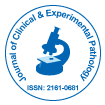Nuestro grupo organiza más de 3000 Series de conferencias Eventos cada año en EE. UU., Europa y América. Asia con el apoyo de 1.000 sociedades científicas más y publica más de 700 Acceso abierto Revistas que contienen más de 50.000 personalidades eminentes, científicos de renombre como miembros del consejo editorial.
Revistas de acceso abierto que ganan más lectores y citas
700 revistas y 15 000 000 de lectores Cada revista obtiene más de 25 000 lectores
Indexado en
- Índice Copérnico
- Google Académico
- sherpa romeo
- Abrir puerta J
- Revista GenámicaBuscar
- TOC de revistas
- Directorio de publicaciones periódicas de Ulrich
- Búsqueda de referencia
- Universidad Hamdard
- EBSCO AZ
- OCLC-WorldCat
- publones
- Fundación de Ginebra para la educación y la investigación médicas
- Pub Europeo
- ICMJE
Enlaces útiles
Revistas de acceso abierto
Comparte esta página
Abstracto
DOCK2: A Potential Target for Obesity Associated Lung Injury
Guoqing Qian, Xia Guo
Obesity is pandemic worldwide and closely associated with many chronic diseases including cardiovascular diseases, diabetes, cancer, and several respiratory diseases. While increasing evidence suggests that obesity is related to lung inflammatory changes, the pathophysiology underling obesity associated lung injury remains poorly understood. Recently, we reported that Dedicator of Cytokinesis 2 (DOCK2) is a potential key factor linking obesity and lung inflammatory injury and fibrosis. Dedicator of Cytokinesis 2 (DOCK2) Deficiency Attenuates Lung Injury Associated with Chronic High-Fat and High-Fructose Diet-Induced Obesity. DOCK2 deficiency not only attenuates high-fat high-fructose diet-induced obesity but also the lung inflammatory infiltration and collagen deposition in the lung of mice. The pro-inflammatory effect of TNF-α was attenuated when DOCK2 was silenced in primary human lung fibroblasts. These findings suggest that DOCK2 may serve as a novel target for obesity related lung injury and fibrosis. We discussed the major findings from this recent study and its limitations that may infer future efforts. In addition, we further discussed the emerging role of DOCK2 in lung inflammation and fibrosis in different contexts (bacterial infection, diet and chemical exposure). This min-review provides an update about the role of DOCK2 in lung injury and fibrosis and may raise interest for further understanding of the molecular mechanisms and translational impacts of DOCK2. Meanwhile, it needs to be acknowledged that much remains to be unveiled towards a comprehensive understanding of the role of DOCK2 in lung inflammation and fibrosis. We briefly discussed several aspects of research that may direct future efforts, e.g., the potential role of DOCK2 in fructose metabolism and signaling, the regulation mechanisms of DOCK2 by different inflammatory cytokines, the Rac dependent and independent role of DOCK2, and the cell-specific role of DOCK2 in obesity related lung injury and fibrosis, etc. In view of the expression of DOCK2 in both immune cells (e.g., macrophages) and non-immune cells (e.g., fibroblasts and epithelial cells), it is anticipated that the role of DOCK2 is a multiple one in obesity related lung injury. Further investigation is warranted to elucidate the role and mechanisms of DOCK2 in lung injury and fibrosis caused by diet and beyond.
Revistas por tema
- Agricultura y acuicultura
- Alimentación y Nutrición
- Bioinformática y biología de sistemas
- Bioquímica
- Ciencia de los Materiales
- Ciencia general
- Ciencias Ambientales
- Ciencias Clínicas
- Ciencias farmacéuticas
- Ciencias Médicas
- Ciencias Sociales y Políticas
- Ciencias Veterinarias
- Enfermería y atención sanitaria
- Física
- Genética y biología molecular
- Geología y Ciencias de la Tierra
- Ingeniería
- Inmunología y Microbiología
- Química
Revistas clínicas y médicas
- Anestesiología
- Biología Molecular
- Cardiología
- Cirugía
- Cuidado de la salud
- Dermatología
- Diabetes y Endocrinología
- Enfermedades infecciosas
- Enfermería
- Gastroenterología
- Genética
- Inmunología
- Investigación clínica
- Medicamento
- Microbiología
- Neurología
- Odontología
- Oftalmología
- Oncología
- Pediatría
- Toxicología

 English
English  Chinese
Chinese  Russian
Russian  German
German  French
French  Japanese
Japanese  Portuguese
Portuguese  Hindi
Hindi